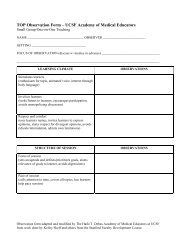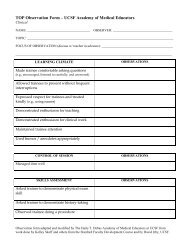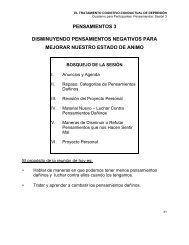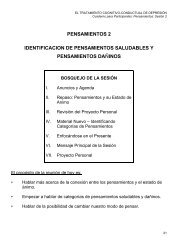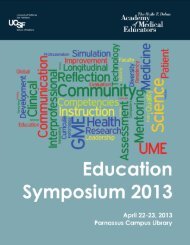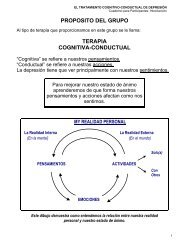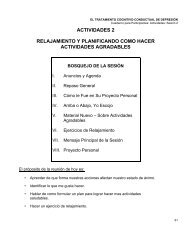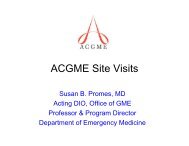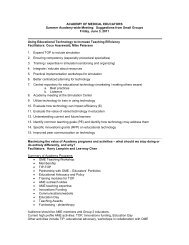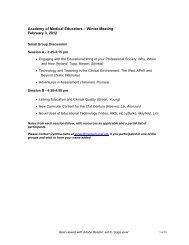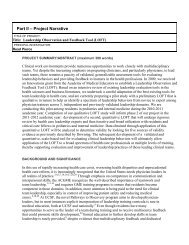2011 - UCSF School of Medicine - University of California, San ...
2011 - UCSF School of Medicine - University of California, San ...
2011 - UCSF School of Medicine - University of California, San ...
You also want an ePaper? Increase the reach of your titles
YUMPU automatically turns print PDFs into web optimized ePapers that Google loves.
<strong>UCSF</strong> Education Day <strong>2011</strong>Curriculum Evaluation & Educational Research Posters2007 - 2010 Match Data from ModelSFGH on Underserved and PrimaryCare Residency ChoiceMargo Vener, MD, MPH, <strong>UCSF</strong>, mvener@fcm.ucsf.edu;Elisabeth Wilson, MD, MPH, <strong>UCSF</strong>,ewilson@fcm.ucsf.edu; Anna Loeb, MS3, <strong>UCSF</strong>,anna.loeb@ucsf.edu; Nili Sommavilla, MS3, <strong>UCSF</strong>,nili.sommavilla@ucsf.edu; Julia Bruckner, MS 3, <strong>UCSF</strong>,julia.bruckner@ucsf.edu; Margaret Wheeler, MD, <strong>UCSF</strong>,mwheeler@medsfgh.ucsf.eduAreas abstract covers: UME, GMEDomain(s) addressed: Career Choice, CurricularInnovation, Primary CarePurpose: To evaluate whether Model SFGH increasesthe number students matching into primary care and/orunderserved residenciesBackground: The US faces a primary care physicianshortage, especially in underserved communities (1).Students trained in underserved programs have morepositive attitudes toward underserved patients (2) andhigher intentions <strong>of</strong> practicing in underservedcommunities (3). Model SFGH is an innovative 6-monthtrack for third-year students interested in urban health.Students complete three semi-integrated clerkships inunderserved settings, follow continuity patients, andwork in community health.Methods: Using match data from 2007-10, wecompared specialty and program choice <strong>of</strong> graduatingstudents who completed Model SFGH (59) to graduatingstudents who had not participated (600). We alsoevaluated match results from 2004-6, before ModelSFGH.Results: Compared to non-participants, Model SFGHstudents have higher rates <strong>of</strong> matching into primary careresidencies (66% vs. 38%), and/or programs inunderserved communities (37% vs. 18%). Compared tothe three years before implementation <strong>of</strong> Model SFGH,this represents an increase in the rate <strong>of</strong> matching intoprimary care for the total graduating class (40% vs 30%)but not an increase in underserved programs (19% vs20%).Discussion: Model SFGH students match morefrequently into primary care and/or underservedresidencies than non-participants. This increase issignificant in training new primary care physicians; sinceModel SFGH began, the total rate <strong>of</strong> <strong>UCSF</strong> graduatesmatching into primary care has increased. Furtherresearch should clarify what curricular factors(peer/faculty support, patient continuity) most pr<strong>of</strong>oundlyimpact students’ decisions.Reflective critique: We presented this work at STFMfor feedback. Further research will track students whowanted to do Model SFGH but were not selected in thelottery.References:1. Center for Workforce Studies, AAMC, 2007.2. Godkin et al, Teach Learn Med. 2006.3. Ko, et al Academic <strong>Medicine</strong>, 2005.A Randomized Trial <strong>of</strong> Hypothesis-Driven versus ScreeningNeurological ExaminationHooman Kamel, MD, <strong>UCSF</strong>, hooman.kamel@ucsf.edu;Gurpreet Dhaliwal, MD, <strong>UCSF</strong>; Maulik Shah, MD, <strong>UCSF</strong>;Amar Dhand, MD, DPhil, <strong>UCSF</strong>; Babak Navi, MD,<strong>UCSF</strong>; S. Andrew Josephson, MD, <strong>UCSF</strong>Areas abstract covers: GMEDomain(s) addressed: Clinical Instruction andPerformancePurpose: We hypothesized that trainees would performbetter using a hypothesis-driven approach to theneurological examination, rather than the traditionalscreening examination.Background: The neurological examination is importantbut complex and difficult to master.Methods: We randomly assigned 16 medical students toperform screening examinations <strong>of</strong> all major aspects <strong>of</strong>neurological function or hypothesis-driven examinationsfocused on aspects suggested by the history. Eachstudent examined 4 patients, two <strong>of</strong> whom had focaldeficits. Outcomes <strong>of</strong> interest were the correctidentification <strong>of</strong> patients with focal deficits, number <strong>of</strong>specific deficits detected, and examination duration.Outcomes were assessed by an investigator blinded togroup assignments. McNemar’s test was used tocompare the sensitivity and specificity <strong>of</strong> the twoexamination methods.Results: Sensitivity was higher with hypothesis-drivenexaminations than screening examinations (78% versus56%; p = 0.046), although specificity was lower (71%versus 100%; p = 0.046). The hypothesis-driven groupidentified 61% <strong>of</strong> specific examination abnormalities,while the screening group identified 53% (p = 0.008).<strong>University</strong> <strong>of</strong> <strong>California</strong>, <strong>San</strong> Francisco • <strong>School</strong> <strong>of</strong> <strong>Medicine</strong> 25



